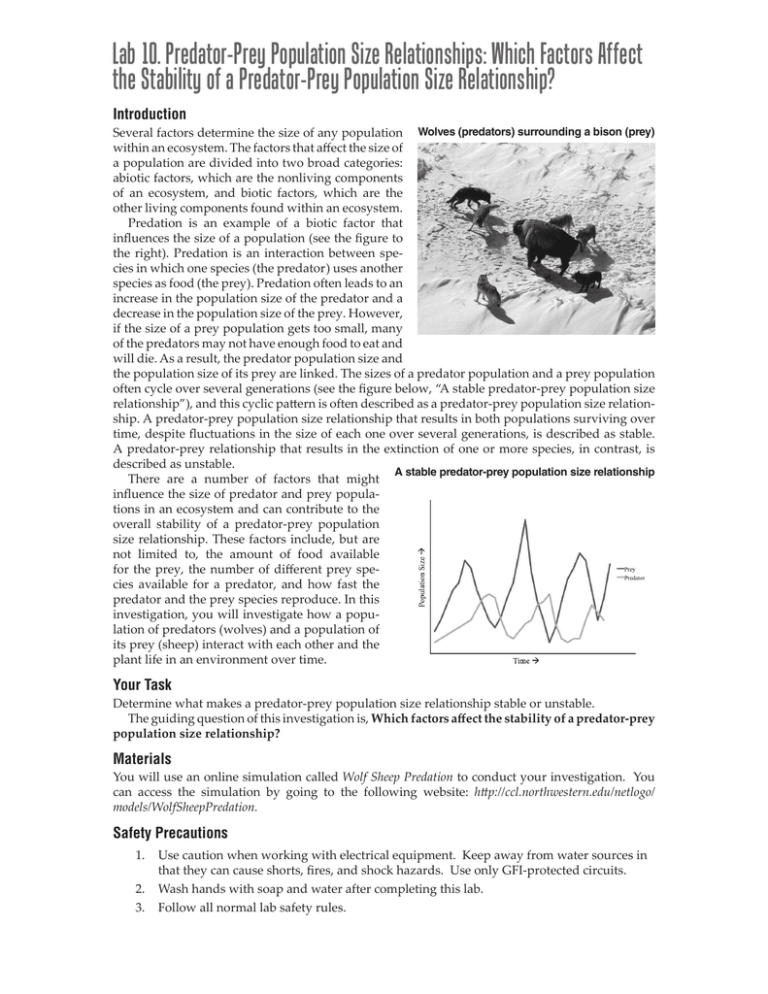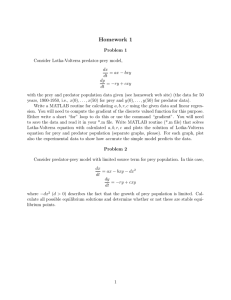Lab 10. Predator-Prey Population Size Relationships: Which Factors
advertisement

Lab 10. Predator-Prey Population Size Relationships: Which Factors Affect the Stability of a Predator-Prey Population Size Relationship? Introduction Several factors determine the size of any population Wolves (predators) surrounding a bison (prey) within an ecosystem. The factors that affect the size of a population are divided into two broad categories: abiotic factors, which are the nonliving components of an ecosystem, and biotic factors, which are the other living components found within an ecosystem. Predation is an example of a biotic factor that influences the size of a population (see the figure to the right). Predation is an interaction between species in which one species (the predator) uses another species as food (the prey). Predation often leads to an increase in the population size of the predator and a decrease in the population size of the prey. However, if the size of a prey population gets too small, many of the predators may not have enough food to eat and will die. As a result, the predator population size and the population size of its prey are linked. The sizes of a predator population and a prey population often cycle over several generations (see the figure below, “A stable predator-prey population size relationship”), and this cyclic pattern is often described as a predator-prey population size relationship. A predator-prey population size relationship that results in both populations surviving over time, despite fluctuations in the size of each one over several generations, is described as stable. A predator-prey relationship that results in the extinction of one or more species, in contrast, is described as unstable. A stable predator-prey population size relationship There are a number of factors that might influence the size of predator and prey populations in an ecosystem and can contribute to the overall stability of a predator-prey population size relationship. These factors include, but are not limited to, the amount of food available for the prey, the number of different prey species available for a predator, and how fast the predator and the prey species reproduce. In this investigation, you will investigate how a population of predators (wolves) and a population of its prey (sheep) interact with each other and the plant life in an environment over time. Your Task Determine what makes a predator-prey population size relationship stable or unstable. The guiding question of this investigation is, Which factors affect the stability of a predator-prey population size relationship? Materials You will use an online simulation called Wolf Sheep Predation to conduct your investigation. You can access the simulation by going to the following website: http://ccl.northwestern.edu/netlogo/ models/WolfSheepPredation. Safety Precautions 1. Use caution when working with electrical equipment. Keep away from water sources in that they can cause shorts, fires, and shock hazards. Use only GFI-protected circuits. 2. Wash hands with soap and water after completing this lab. 3. Follow all normal lab safety rules. Getting Started A screen shot from the Wolf Sheep Predation simulation The Wolf Sheep Predation simulation allows you to explore the stability of the predator-prey population size relationship (see the figure to the right) between a population of wolves (the predator) and a population of sheep (the prey). In the simulation, wolves and sheep wander around the landscape at random. The wolves lose energy with each step, and when they run out of energy they die. The wolves therefore must eat sheep to replenish their energy. You can set the simulation so there is an unlimited amount of food for the sheep to eat (grass off) or you can set the simulation so it includes a limited amount of grass in the ecosystem (grass on). If you decide to leave grass out of the simulation, the sheep never run out of energy and they only die when a wolf eats them. If you decide to include grass in the simulation, the sheep must eat grass to maintain their energy; when they run out of energy, they die. Once grass is eaten by a sheep it will only regrow after a fixed amount of time; you can adjust the amount of time it takes for grass to regrow. You can also set other factors such as the initial population size of the wolves and the sheep and what percentage of the wolves and sheep reproduce with each “tick” of the simulation (each tick represents a set amount of time—in this case a day). To answer the guiding question, you must determine what type of data you will need to collect, how you will collect it, and how you will analyze it. To determine what type of data you will need to collect, think about the following questions: • How will you determine if a predator-prey relationship is stable? • What will serve as your dependent variable (number of wolves, number of sheep, and so on)? • What type of measurements or observations will you need to record during your investigation? To determine how you will collect your data, think about the following questions: • What will serve as a control (or comparison) condition? • What types of treatment conditions will you need to set up and how will you do it? • How often will you collect data and when will you do it? • How will you make sure that your data are of high quality (i.e., how will you reduce error)? • How will you keep track of the data you collect and how will you organize the data? To determine how you will analyze your data, think about the following questions: • How will you determine if there is a difference between the treatment conditions and the control condition? • What type of calculations will you need to make? • What type of graph could you create to help make sense of your data? Investigation Proposal Required? Yes No Connections to Crosscutting Concepts and to the Nature of Science and the Nature of Scientific Inquiry As you work through your investigation, be sure to think about • the importance of identifying patterns, • the importance of identifying the underlying cause for observations, • how models are used to study natural phenomena, • how systems go through periods of stability and change, • how social and cultural factors influence the work of scientists, and • different methods used in scientific investigations. Argumentation Session Argument presentation on a whiteboard Once your group has finished collecting and anaThe Guiding Question: lyzing your data, prepare a whiteboard that you can use to share your initial argument. Your whiteboard Our Claim: should include all the information shown in the figure to the right. To share your argument with others, we will be Our Evidence: Our Justification using a round-robin format. This means that one of the Evidence: member of your group will stay at your lab station to share your group’s argument while the other members of your group go to the other lab stations one at a time to listen to and critique the arguments developed by your classmates. The goal of the argumentation session is not to convince others that your argument is the best one; rather, the goal is to identify errors or instances of faulty reasoning in the arguments so these mistakes can be fixed. You will therefore need to evaluate the content of the claim, the quality of the evidence used to support the claim, and the strength of the justification of the evidence included in each argument that you see. In order to critique an argument, you will need more information than what is included on the whiteboard. You might, therefore, need to ask the presenter one or more follow-up questions, such as: • How did you use the simulation to collect your data? • What did you do to analyze your data? Why did you decide to do it that way? Did you check your calculations? • Is that the only way to interpret the results of your analysis? How do you know that your interpretation of your analysis is appropriate? • Why did your group decide to present your evidence in that manner? • What other claims did your group discuss before you decided on that one? Why did your group abandon those alternative ideas? • How confident are you that your claim is valid? What could you do to increase your confidence? Once the argumentation session is complete, you will have a chance to meet with your group and revise your original argument. Your group might need to gather more data or design a way to test one or more alternative claims as part of this process. Remember, your goal at this stage of the investigation is to develop the most valid or acceptable answer to the research question! Report Once you have completed your research, you will need to prepare an investigation report that consists of three sections that provide answers to the following questions: 1. What question were you trying to answer and why? 2. What did you do during your investigation and why did you conduct your investigation in this way? 3. What is your argument? Your report should answer these questions in two pages or less. This report must be typed, and any diagrams, figures, or tables should be embedded into the document. Be sure to write in a persuasive style; you are trying to convince others that your claim is acceptable or valid!



